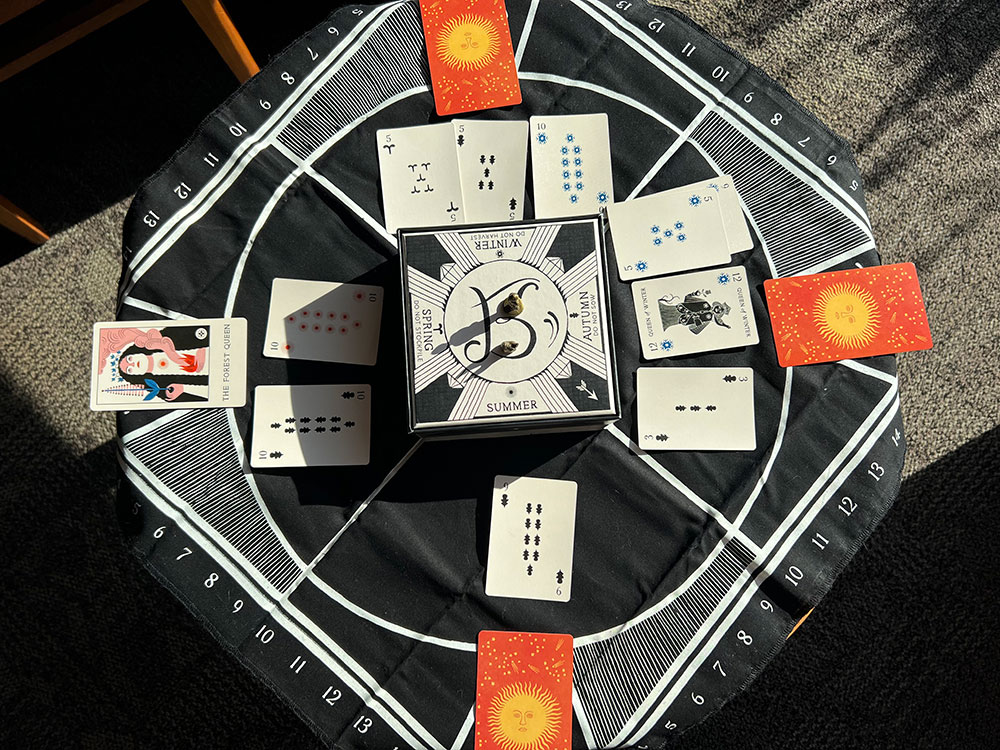 Strange cards are arrayed in front of you, carefully positioned on an inky, black cloth. Like tarot cards, they are each imbued with meaning, full of possibility to change your fortunes. You look at the cards in your hand, and you run through calculations in your head. Can you clear the field of summer and capture The Forest Queen, ending her tyranny over the seasons? Or do you risk triggering a new set of rules, unsure of what lies hidden within? A tiny bronze bear tooth sits in the center of the board, waiting for you to make your decision.
Strange cards are arrayed in front of you, carefully positioned on an inky, black cloth. Like tarot cards, they are each imbued with meaning, full of possibility to change your fortunes. You look at the cards in your hand, and you run through calculations in your head. Can you clear the field of summer and capture The Forest Queen, ending her tyranny over the seasons? Or do you risk triggering a new set of rules, unsure of what lies hidden within? A tiny bronze bear tooth sits in the center of the board, waiting for you to make your decision.
Illimat, by Twogether Studios, is a card game for 1-4 players that is deceptively simple to learn, but tricky to master.
Gameplay Overview:
The goal of the game is to be the first player to reach 17 points over the course of several rounds of play. The game board is a cloth mat with quadrants with “fields” screen-printed onto it. The game’s box lid is upturned and placed into the center of the cloth, becoming “the Illimat.” Players are dealt a hand of cards from the deck, which contains five suits with values 1-14. Into each field, three cards are placed face up, and one tarot-sized Luminary card is placed facedown. A bronze Okus token goes in the middle of the Illimat for each player in the game.

On a player’s turn, they can perform one of three actions. The first is to sew, placing one of the cards in their hand into a field on the board. The second option is to stockpile, playing a card from their hand on top of a card already in the field, creating a stack with a higher value (playing a three from your hand onto an existing four in the field, thus making that card’s new total value a seven). The third action, which is how the player earns the majority of their points, is harvesting. They reveal a card from their hand (a ten, for instance) and then may take any card or combination of cards in any/all fields that equal the valu eof their card as a trick (if the field has another ten in it, or two fives, or a stockpile that has an eight and a two, or all of the above, they are captured from the field by that player).
If a field is ever emptied of cards, the Luminary card in the corner is flipped over, and that Luminary’s special conditions are now applied to the game, essentially adding a new rule. The player who causes the Luminary to flip also claims an Okus token for their score pile. When face cards (11-14) are played, it can trigger the Illimat to move, changing the season, and each season has its own action limitations, changing the game’s rules. Players earn bonus points by clearing a field a second time to claim the Luminary card, taking Okus tokens, or collecting cards in specific suits. The first player to exceed 17 points wins.

Game Experience:
The designers intended Illimat to make you feel like it could be a relic from a previous time. While at its heart it is a new interpretation of traditional trick-taking card games, in each rulebook and expansion you’ll find lore crafted to add to the mystery of the game’s fictional origins. The game’s true creation story is just as, if not more, interesting.

The band The Decemberists reached out to game designers Keith Barker and Jennifer Ellis after a photoshoot where they created a fictional game to see if the designers could take the concept art and make a game out of it. The design talents of Barker and Ellis (proven in games like Gloom), the storytelling skills of the band’s front man Colin Meloy (also a New York Times Bestselling author) and the art of Carson Ellis (A Caldecott Honor-awarded illustrator) combined to create the game Illimat. It captures the whimsical tone of something created by an indie folk band, but can be played in its entirety without foreknowledge of the source material.
The strategy of how to line the cards up to claim as many as possible, while also working within the constraints of each season and Luminary-based rules, creates depth and challenge to an otherwise simple ruleset. The actions are easy to learn, but allow for enough decision space and advanced planning that they can satisfy a more strategic player. It’s a game that rewards cleverness and luck in equal measure.

Illimat does a great job of building tension slowly as you play. Decisions made at the beginning of the round seem easy, but as the fields begin to clear and your choices narrow, the pressure behind every card play increases. While the game has enough DNA in common with traditional card games like rummy or euchre to recommend itself to casual players, the strong thematic tone and narrative have built a cult-like following among hobby board gamers who appreciate the artistry.
Final Thoughts:
Illimat is undoubtedly a beautiful game. It has a unique table presence that uses bright pops of color against a monochromatic background to create visual interest. Each component feels high quality and well crafted. The rules are quick to teach and easy to learn.
I’ve noticed new players often struggle with the Stockpile action, however, unsure how to use it to their benefit. Even advanced players use this option less frequently, as it can inadvertently be used against you in 3-4 player games. The rulesbook released with the second edition has clarified how Stockpile works, but it still doesn’t click as well as the other actions. There are two expansions for Illimat that include additional packs of Luminaries to incorporate into the base game, and also the deluxe Syzygy Coin that doubles as an Okus and adds optional challenges.
Final Score: 4 Stars – A beautifully produced, very playable game. Some details of the rules can be harder to pick up for beginners.
 Hits:
Hits:
• High quality production value with luxe components
• Quick to learn
Misses:
• Some card actions are more difficult to implement in practice
• The $30 price tag may feel high for a simple game.






















Good game, while not my favorite atleast it has replayability. I agree 4 stars and love the description and explanations